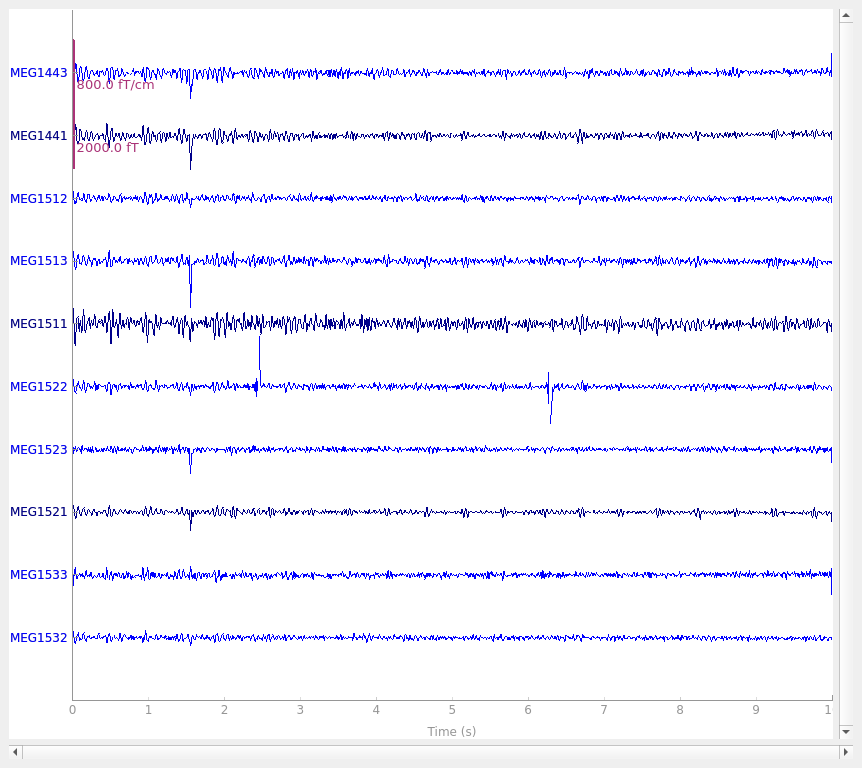Note
Click here to download the full example code
Plot sensor denoising using oversampled temporal projection#
This demonstrates denoising using the OTP algorithm [1] on data with with sensor artifacts (flux jumps) and random noise.
# Author: Eric Larson <larson.eric.d@gmail.com>
#
# License: BSD-3-Clause
import mne
import numpy as np
from mne import find_events, fit_dipole
from mne.datasets.brainstorm import bst_phantom_elekta
from mne.io import read_raw_fif
print(__doc__)
Plot the phantom data, lowpassed to get rid of high-frequency artifacts. We also crop to a single 10-second segment for speed. Notice that there are two large flux jumps on channel 1522 that could spread to other channels when performing subsequent spatial operations (e.g., Maxwell filtering, SSP, or ICA).
dipole_number = 1
data_path = bst_phantom_elekta.data_path()
raw = read_raw_fif(data_path / 'kojak_all_200nAm_pp_no_chpi_no_ms_raw.fif')
raw.crop(40., 50.).load_data()
order = list(range(160, 170))
raw.copy().filter(0., 40.).plot(order=order, n_channels=10)

Opening raw data file /home/circleci/mne_data/MNE-brainstorm-data/bst_phantom_elekta/kojak_all_200nAm_pp_no_chpi_no_ms_raw.fif...
Read a total of 13 projection items:
planar-0.0-115.0-PCA-01 (1 x 306) idle
planar-0.0-115.0-PCA-02 (1 x 306) idle
planar-0.0-115.0-PCA-03 (1 x 306) idle
planar-0.0-115.0-PCA-04 (1 x 306) idle
planar-0.0-115.0-PCA-05 (1 x 306) idle
axial-0.0-115.0-PCA-01 (1 x 306) idle
axial-0.0-115.0-PCA-02 (1 x 306) idle
axial-0.0-115.0-PCA-03 (1 x 306) idle
axial-0.0-115.0-PCA-04 (1 x 306) idle
axial-0.0-115.0-PCA-05 (1 x 306) idle
axial-0.0-115.0-PCA-06 (1 x 306) idle
axial-0.0-115.0-PCA-07 (1 x 306) idle
axial-0.0-115.0-PCA-08 (1 x 306) idle
Range : 47000 ... 437999 = 47.000 ... 437.999 secs
Ready.
Reading 0 ... 10000 = 0.000 ... 10.000 secs...
Filtering raw data in 1 contiguous segment
Setting up low-pass filter at 40 Hz
FIR filter parameters
---------------------
Designing a one-pass, zero-phase, non-causal lowpass filter:
- Windowed time-domain design (firwin) method
- Hamming window with 0.0194 passband ripple and 53 dB stopband attenuation
- Upper passband edge: 40.00 Hz
- Upper transition bandwidth: 10.00 Hz (-6 dB cutoff frequency: 45.00 Hz)
- Filter length: 331 samples (0.331 sec)
[Parallel(n_jobs=1)]: Using backend SequentialBackend with 1 concurrent workers.
[Parallel(n_jobs=1)]: Done 1 out of 1 | elapsed: 0.0s remaining: 0.0s
[Parallel(n_jobs=1)]: Done 2 out of 2 | elapsed: 0.0s remaining: 0.0s
[Parallel(n_jobs=1)]: Done 3 out of 3 | elapsed: 0.0s remaining: 0.0s
[Parallel(n_jobs=1)]: Done 4 out of 4 | elapsed: 0.0s remaining: 0.0s
[Parallel(n_jobs=1)]: Done 306 out of 306 | elapsed: 0.2s finished
Now we can clean the data with OTP, lowpass, and plot. The flux jumps have been suppressed alongside the random sensor noise.
raw_clean = mne.preprocessing.oversampled_temporal_projection(raw)
raw_clean.filter(0., 40.)
raw_clean.plot(order=order, n_channels=10)

Processing MEG data using oversampled temporal projection
Processing 1 data chunk of (at least) 10.0 sec with 5.0 sec overlap and hann windowing
The final 0.001 sec will be lumped into the final window
Denoising 0.00 - 10.00 sec
Denoising 10.00 - 10.00 sec
Filtering raw data in 1 contiguous segment
Setting up low-pass filter at 40 Hz
FIR filter parameters
---------------------
Designing a one-pass, zero-phase, non-causal lowpass filter:
- Windowed time-domain design (firwin) method
- Hamming window with 0.0194 passband ripple and 53 dB stopband attenuation
- Upper passband edge: 40.00 Hz
- Upper transition bandwidth: 10.00 Hz (-6 dB cutoff frequency: 45.00 Hz)
- Filter length: 331 samples (0.331 sec)
[Parallel(n_jobs=1)]: Using backend SequentialBackend with 1 concurrent workers.
[Parallel(n_jobs=1)]: Done 1 out of 1 | elapsed: 0.0s remaining: 0.0s
[Parallel(n_jobs=1)]: Done 2 out of 2 | elapsed: 0.0s remaining: 0.0s
[Parallel(n_jobs=1)]: Done 3 out of 3 | elapsed: 0.0s remaining: 0.0s
[Parallel(n_jobs=1)]: Done 4 out of 4 | elapsed: 0.0s remaining: 0.0s
[Parallel(n_jobs=1)]: Done 306 out of 306 | elapsed: 0.2s finished
We can also look at the effect on single-trial phantom localization. See the Brainstorm Elekta phantom dataset tutorial for more information. Here we use a version that does single-trial localization across the 17 trials are in our 10-second window:
def compute_bias(raw):
events = find_events(raw, 'STI201', verbose=False)
events = events[1:] # first one has an artifact
tmin, tmax = -0.2, 0.1
epochs = mne.Epochs(raw, events, dipole_number, tmin, tmax,
baseline=(None, -0.01), preload=True, verbose=False)
sphere = mne.make_sphere_model(r0=(0., 0., 0.), head_radius=None,
verbose=False)
cov = mne.compute_covariance(epochs, tmax=0, method='oas',
rank=None, verbose=False)
idx = epochs.time_as_index(0.036)[0]
data = epochs.get_data()[:, :, idx].T
evoked = mne.EvokedArray(data, epochs.info, tmin=0.)
dip = fit_dipole(evoked, cov, sphere, n_jobs=None, verbose=False)[0]
actual_pos = mne.dipole.get_phantom_dipoles()[0][dipole_number - 1]
misses = 1000 * np.linalg.norm(dip.pos - actual_pos, axis=-1)
return misses
bias = compute_bias(raw)
print('Raw bias: %0.1fmm (worst: %0.1fmm)'
% (np.mean(bias), np.max(bias)))
bias_clean = compute_bias(raw_clean)
print('OTP bias: %0.1fmm (worst: %0.1fmm)'
% (np.mean(bias_clean), np.max(bias_clean),))
Raw bias: 2.5mm (worst: 5.2mm)
OTP bias: 1.2mm (worst: 1.3mm)
References#
Total running time of the script: ( 0 minutes 20.692 seconds)
Estimated memory usage: 89 MB